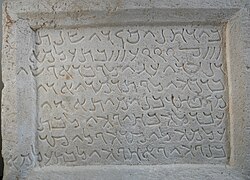Palmyrene_alphabet
Palmyrene alphabet
Historical Middle Eastern alphabet
The Palmyrene alphabet was a historical Semitic alphabet used to write Palmyrene Aramaic. It was used between 100 BCE and 300 CE in Palmyra in the Syrian desert. The oldest surviving Palmyrene inscription dates to 44 BCE.[2] The last surviving inscription dates to 274 CE, two years after Palmyra was sacked by Roman Emperor Aurelian, ending the Palmyrene Empire. Use of the Palmyrene language and script declined, being replaced with Greek and Latin.

The Palmyrene alphabet was derived from cursive versions of the Aramaic alphabet and shares many of its characteristics:[3][4]
- Twenty-two letters with only consonants represented
- Written horizontally from right-to-left
- Numbers written right-to-left using a non-decimal system
Palmyrene was normally written without spaces or punctuation between words and sentences (scriptio continua style).
Two forms of the Palmyrene alphabet were developed: The rounded, cursive form derived from the Aramaic alphabet and later a decorative, monumental form developed from the cursive Palmyrene.[2] Both the cursive and monumental forms commonly used orthographic ligatures.[4]
